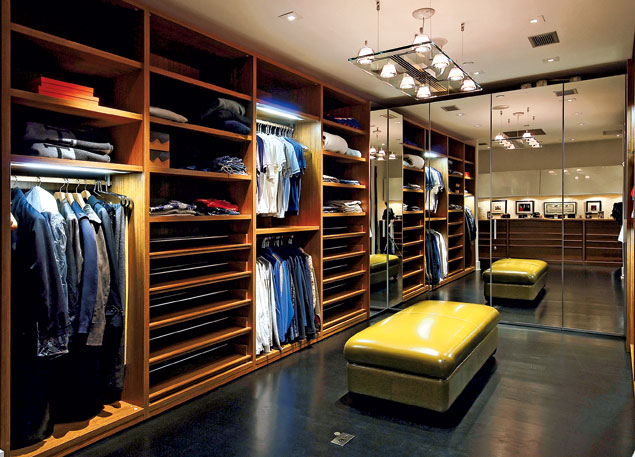When Ron Ginsburg set about building a new house in DC’s Forest
Hills, he put a premium on closet space, especially in his bedroom. “I
wanted there to be room for a lot of things, but I wanted it to be
organizable,” he says. And because you have to pass through the closet
area to reach the master bath, the space had to look good.
He approached designer Vincent Sagart at Poliform Sagartstudio
in DC for help with the closet. Architect John Coplen of the Alter Urban
Design Collaborative was designing the entire home.
Having created large closet systems for years, Sagart knows
intuitively how men and women dress themselves—and he designs
accordingly.
“Women need to mix and match every day,” he says, so every
component of an outfit needs to be within view. “Guys want to dress every
day in something they know—it’s more cerebral,” so the shirts don’t
necessarily have to be hanging next to the jackets or ties.
Sagart built a space that not only worked for Ginsburg but
could also be reconfigured as circumstances changed, which they did when
Ginsburg’s partner moved in recently. Now there are more double-hanging
spaces to accommodate additional suits and dress shirts, and the shoe
racks were switched out for sweater shelves.
“The last thing I wanted was absolutely fixed shelving and
absolutely fixed hanging materials,” Ginsburg says. A built-in dresser was
also crafted for two people, even though Ginsburg was single at the time.
He was thinking about resale, but the dresser has come in handy now that
he’s part of a couple.
Sagart accomplished with Ginsburg what he sets out to do with
every project: “We always strive to create a dressing room or closet that
does not look like a storage room full of stuff,” he says. “We want a
space that is just enjoyable to be in.”
In Ginsburg’s case, Sagart designed the space as a sort of
gentleman’s lounge. Dark wood and soft lighting illuminate not only the
neatly hung wardrobe but a comfortable ottoman in the middle and, on the
side, a dresser that would feel at home as a sideboard in any other
room—decorated with Ginsburg’s collected art and artifacts. The homeowner
specifically asked for sturdy, beautiful materials in his closet that
wouldn’t get “chipped and nicked and dented and scratched.”
Says Ginsburg: “I wanted it to be comfortable and masculine. I
wanted it to be something that would stand out.”
Closet Tips
-
Purge. You’ve heard it before, but it bears
repeating: Take everything out of your closet, and put back in only those
items you’ve worn in the past year, architect John Coplen says. Give
everything else away. A good time for this exercise is when you’re
switching out clothes for a new season. -
Examine how you live—and be honest. If you’re
home with the kids and no longer wear business suits, don’t spare valuable
real estate in your closet for them. Think about more racks for casualwear
instead. -
Have a goal. What do you hate about your
closet now? What would make it better? Designer Vincent Sagart says, “Make
it an experience that is enjoyable, not driving you crazy.” For women
especially, he adds, a closet should be designed so they can see clothing,
accessories, bags, and shoes all at once, allowing them to create an
ensemble easily. -
Get help. Retailers and companies at all price
levels can design a closet system that maximizes every inch—you just need
to provide the closet’s dimensions. Poliform resides at the high end, but
Coplen also likes the Elfa products at the Container Store for more
budget-conscious organizers. In between this high and low, he recommends
California Closets and ClosetMaid.


















